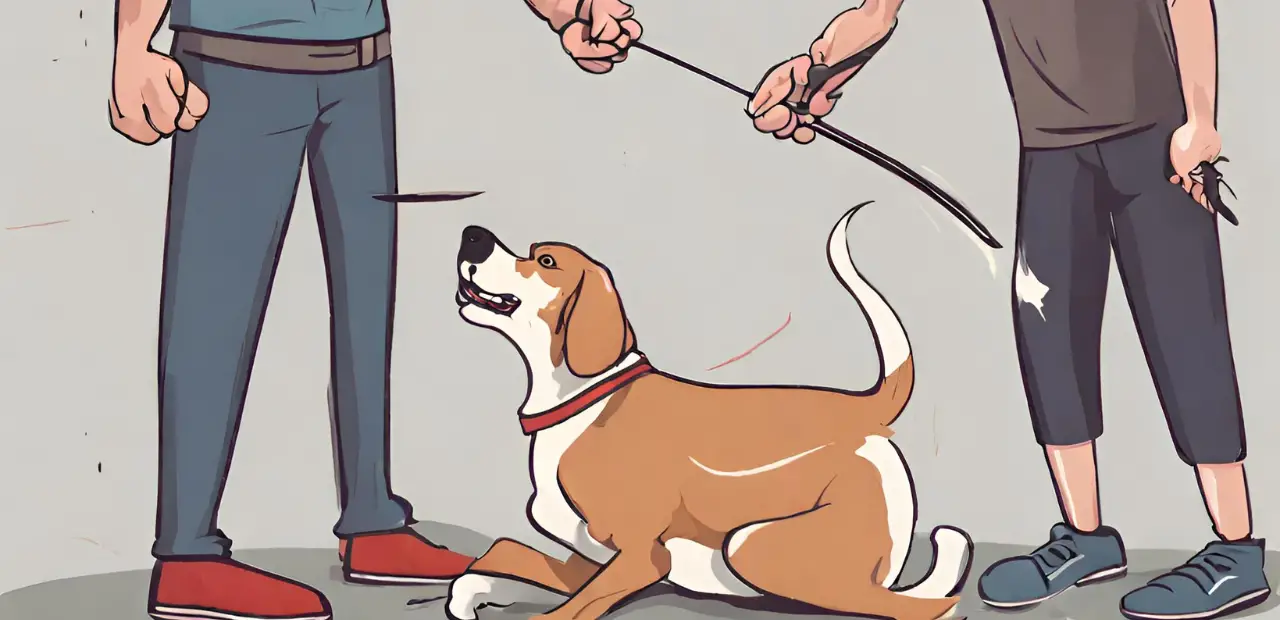Dog-on-dog aggression is a serious issue that requires attention and appropriate discipline. When a dog attacks another dog, it not only puts both animals in harm’s way but also raises concerns for the safety of other pets and humans. Understanding the root causes of aggression and implementing effective discipline techniques can help address this alarming problem and ensure the well-being of all involved.
Understanding Dog Aggression
Canine behaviour: Exploring the roots of aggression
To effectively discipline a dog for attacking another dog, it is crucial to have a comprehensive understanding of canine behaviour. Dogs can display aggression for various reasons, such as fear, resource guarding, territoriality, or dominance. Recognizing and addressing the underlying causes is essential for successful discipline.
Identifying different types of aggression
Dogs can display various forms of aggression, encompassing fear-based aggression, territorial aggression, and social aggression, among others. Each type requires a specific approach to discipline. By identifying the particular aggression type, owners can tailor their disciplinary actions accordingly.
Recognizing warning signs and triggers
Before a dog attack occurs, there are often warning signs and triggers that indicate potential aggression. Growling, baring teeth, raised hackles, and stiff body posture are common warning signs. Identifying these signs and understanding possible motivations can help owners intervene and prevent aggressive behaviour.
Safety First: Immediate Actions to Take
Separating the dogs: Preventing further harm
When a dog attack occurs, immediate action is necessary to prevent further harm. Safely and quickly separating the dogs using a barrier, leash, or physical intervention can protect both animals from additional injury.
Assessing injuries and seeking veterinary attention
After separating the dogs, it is essential to assess the extent of any injuries. Seeking veterinary attention promptly is crucial, as injuries may not always be apparent on the surface and require professional evaluation and treatment.
Ensuring the safety of all involved parties
In addition to isolating the dogs, it’s equally imperative to safeguard the well-being of all individuals involved in the incident, which includes other pets and humans. Removing them from the immediate area can prevent any accidental injuries or escalations.

The Role of Training in Curbing Aggression
The significance of early socialization and obedience training
Early socialization and obedience training are vital in preventing and curbing dog aggression. By exposing them to various environments, people, and animals from a young age, dogs develop better social skills and are less likely to exhibit aggressive behaviour later in life.
Utilizing positive reinforcement methods
Positive reinforcement is an exceptionally successful method for training and shaping dogs’ behaviour. Rewarding desired actions and behaviours with treats, praise, or playtime can encourage dogs to repeat those behaviours while discouraging aggression through redirection and non-reward.
Seeking professional help: The value of a dog trainer or behaviourist
In some cases, professional assistance from a dog trainer or behaviourist may be necessary. These experts can provide specialized guidance, create a tailored training plan, and offer additional support to address dog-on-dog aggression effectively.
Mending Manners: Behavior Modification Techniques
Establishing clear boundaries and rules
Consistency in enforcing boundaries and rules is crucial for correcting dog aggression. Establishing clear expectations and consistently reinforcing them can help dogs understand their roles and prevent them from engaging in aggressive behaviour.
Consistency and routine: Building trust and confidence
Dogs thrive in environments with consistent routines. By providing a structured way and predictable daily activities, dogs feel more secure, reducing anxiety and the likelihood of aggressive outbursts.
Controlled exposure to other dogs for desensitization
Gradually exposing an aggressive dog to controlled interactions with other dogs, under professional guidance, helps desensitize them to triggers that may provoke aggression. Controlled exposure can progressively build their tolerance and improve their behaviour around other dogs.
The Power of Communication: Effective Owner-Dog Interaction
The importance of assertive but calm leadership
Establishing oneself as a calm and assertive leader in the dog-owner relationship is essential. Dogs respond well to confident leadership, and when provided with clear guidance, they are less likely to display aggressive behaviour.
Non-verbal cues: Using body language to modify behaviour
Dogs are highly adept at reading human body language. Utilizing non-verbal cues effectively can communicate expectations and modify behaviour. Calm and assertive body language can positively influence a dog’s behaviour and prevent aggression.
Reinforcing the human-dog bond through play and exercise
Regular play and exercise sessions with a dog help strengthen the bond between the owner and the dog. A strong bond contributes to better behaviour, trust, and overall obedience, reducing the chances of aggressive episodes.
Managing Dog-on-Dog Aggression in Real-Life Situations
Walks in public spaces: Tips for avoiding confrontations
When walking a dog with a history of aggression, it is essential to take precautions and avoid potential confrontations. Choosing less crowded routes, keeping a safe distance from other dogs, and using a muzzle or a leash with proper restraints are effective strategies for managing aggression during walks.
Introducing new dogs: Gradual and controlled encounters
Introducing a new dog to an aggressive canine demands patience and a carefully phased approach. Controlled encounters, initially through scent swapping and later in controlled environments, allow dogs to become familiar with each other safely.
Dog parks: Ensuring a safe and controlled environment
Dog parks can be challenging for dogs with a history of aggression. Owners must ensure a safe and controlled environment by closely monitoring their dog’s behaviour, keeping them on a leash if necessary, and intervening at the first sign of aggression.
Alternative Approaches to Discipline
The responsible role of aversive training tools
Aversive training tools, such as shake cans or squirt bottles, can be used responsibly to deter aggressive behaviour. However, their use should always be carefully considered, and their effectiveness may vary depending on the dog and the specific situation.
Exploring techniques such as shake cans and squirt bottles
Shake cans and squirt bottles can startle dogs and redirect their attention during aggressive episodes. This technique can be effective in interrupting negative behaviour patterns and redirecting the dog to more appropriate actions.
The controversies surrounding punishment-based methods
Punishment-based methods of discipline, such as physical corrections or harsh reprimands, are controversial and often discouraged. They can create fear anxiety, and potentially worsen aggression problems. It is essential to opt for positive reinforcement-based approaches whenever possible.
Creating a Supportive Environment at Home
The impact of a structured routine on behaviour
A structured routine at home provides dogs with a sense of security and predictability. Following a consistent schedule for feeding, exercise, training, and playtime, dogs are less likely to develop anxiety or engage in aggressive behaviour.
Providing mental stimulation: The benefits of puzzle toys
Mental stimulation through puzzle toys, interactive games, and training exercises is essential for preventing boredom-related aggression. These activities engage a dog’s mind and redirect their energy towards more productive and non-aggressive outlets.
Ensuring a calm and harmonious family environment
A calm and harmonious family environment is crucial for curbing dog aggression. Consistent behaviour from all family members, clear communication, and avoiding conflict or tension within the household contribute to overall positive behaviour in dogs.
Troubleshooting Common Challenges
Aggression towards family members: Addressing fear or dominance
When a dog shows aggression towards family members, it’s crucial to pinpoint and address the underlying cause. Fear or dominance issues are common underlying factors. Addressing the specific cause through training, behaviour modification, and seeking professional help if needed can help resolve the aggression.
Barrier frustration: Dealing with aggression behind fences or windows
Barrier frustration can trigger aggressive behaviour in dogs when they cannot physically access something or someone. Modifying the environment, providing alternative outlets for their energy, and gradual desensitization can help alleviate this aggression.
Handling redirected aggression effectively
In cases of redirected aggression, where a dog turns their charge towards an innocent party, precise interventions are necessary. Interrupting the behaviour, diverting their attention, and creating a safe separation can help manage and reduce the occurrence of redirected aggression.
Summary and Concluding Thoughts
The journey to discipline a dog for attacking another dog requires patience, consistency, and a deep understanding of canine behaviour. By exploring the root causes of aggression, implementing appropriate training techniques, and creating a supportive environment, long-term behaviour improvement is possible. Emphasizing patience, consistency, and positive reinforcement can lead to a safer and more harmonious relationship between dogs, their owners, and the community.
FAQs
Can all dogs overcome aggression towards other dogs?
Not all dogs can overcome aggression towards other dogs.
Is it possible to train a dog without professional assistance?
Yes, it is possible to train a dog without professional assistance.
How long does it usually take to see improvements in behavior?
The time to see behavior improvements varies, but consistency is key.
Are certain breeds more prone to dog-on-dog aggression?
Certain breeds may have a higher predisposition to dog-on-dog aggression.
- Smelly House Because of Dog? Take These Hygiene Tips - May 20, 2025
- How to Introduce a Dog To a Cats Without Chaos - May 6, 2025
- 4 Best Cavapoo Rescues in the UK 2024 - April 5, 2024








